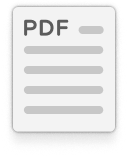When it comes to digital documents, PDF remains the gold standard: universal, reliable, easy to share, and widely compatible with all devices and software. However, for the long-term preservation of sensitive files—legal, administrative, heritage—it may be useful to turn to a more specialised version: PDF/A.
A version designed for archiving
PDF/A (‘A’ for ‘archivable’) is an ISO standard derived from PDF. It was designed to ensure that a digital document remains readable, complete and faithful to its original appearance, even after several decades.
To achieve this robustness, PDF/A imposes certain technical constraints: unlike PDF, it avoids elements that may cause problems in the long term, such as interactive content, external dependencies or evolving technologies.
A PDF/A file is therefore ‘self-contained’: it includes everything necessary for display (fonts, metadata, etc.) without depending on the software or reading environment.
Standard PDF vs PDF/A: what are the differences?
Visually, a PDF/A file looks very similar to a standard PDF file. However, several distinctions make it the preferred choice for digital archiving:
- It excludes dynamic content (videos, sounds, interactive forms, JavaScript).
- It requires all fonts to be embedded in the file.
- It requires the inclusion of standardised metadata.
- It prohibits encryption to ensure accessibility over time.
These specific features are not limitations, but guarantees for the longevity of the document.
When should you consider PDF/A?
PDF/A is particularly relevant in contexts where reliable document preservation is essential. It is often used by government agencies, regulated professions, or for archiving documents with legal value: contracts, court decisions, notarial deeds, electronic invoices, heritage archives, etc.
Adopting this format allows you to commit to a sustainable document management approach while anticipating technological developments.
See also: Why use PDFSmart in the legal sector?
Towards sustainable document management
At a time when businesses and individuals are increasingly moving towards paperless operations, the issue of digital preservation is becoming increasingly important. PDF/A does not always replace traditional PDF, but it is a suitable solution for issues of longevity, traceability and regulatory compliance.
PDF: a format that is still relevant
However, PDF and PDF/A should not be seen as mutually exclusive. Traditional PDF remains perfectly suited to a wide variety of everyday needs. Whether for sharing interactive documents, embedding links or dynamic forms, or simply transmitting files that can be easily read on all devices, the PDF format remains as relevant as ever. Its flexibility makes it an indispensable tool for communication, collaboration and everyday document management.






